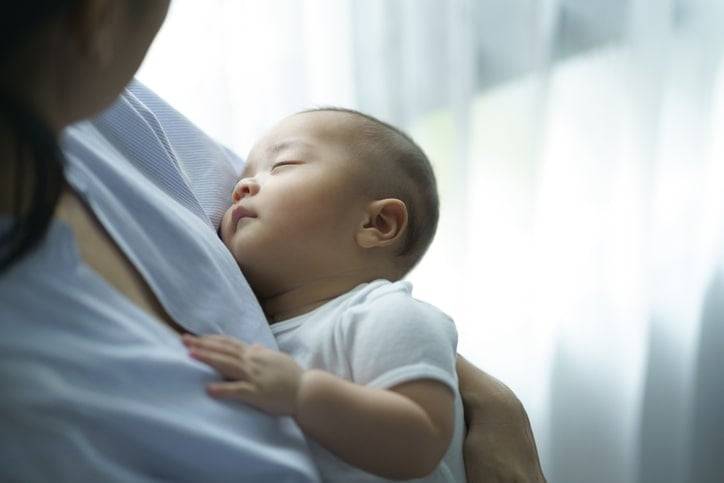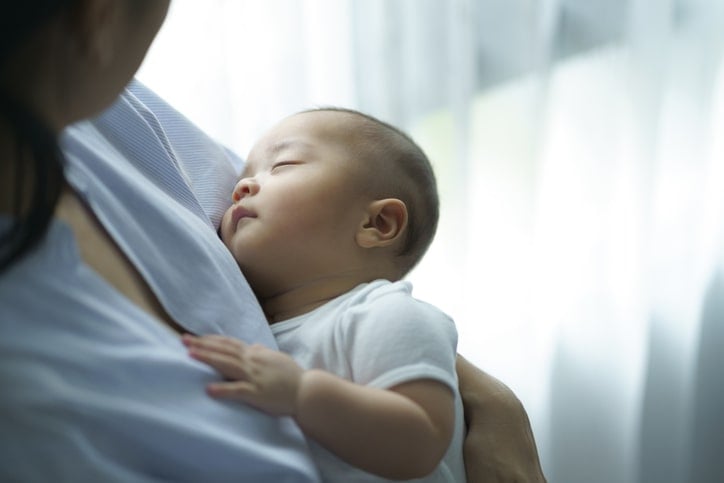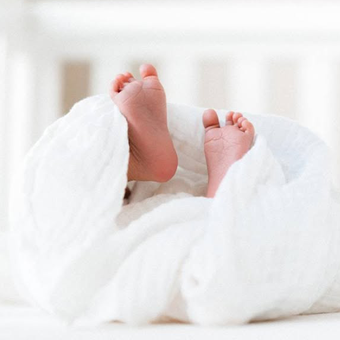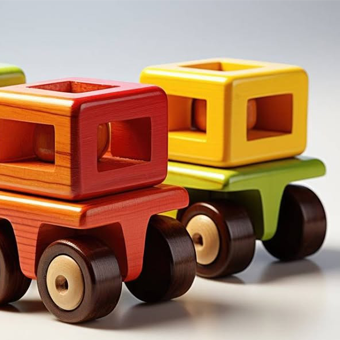How to soothe a crying baby to sleep

Your baby won’t stop crying, and you ache for some peace and quiet. Is there a way to get your baby to fall asleep – and remain sleeping – even after you’ve set your baby down in bed? A recent study sheds light on a promising tactic: Walk for 5 minutes with your baby held securely in your arms, then continue holding your baby (while seated) for another 5-8 minutes before trying to lay your baby down.

As the study authors note, their results need to be replicated. But this “walk, then wait” tactic meshes with what we know from prior research. When we walk with our babies, it tends to relax them, making it more likely that they will fall asleep. And, after falling asleep, it takes a while for babies to move from light sleep (when they are easily awakened by movement or noise) to deep sleep (when they are more likely to sleep through disruptions, like being laid down in a crib).
In what follows, I explain the science in more detail, so you can draw your own conclusions about how and when to use this tactic at home. But the quick takeaway? There’s a good chance that the method will lull your crying baby to sleep. As long as you’re in a position to implement the procedure safely, this is a relatively easy, low-stress, low-risk option to try.
Evidence that walking with babies – not merely holding them – is the key to inducing physiological calm
At the RIKEN Center for Brain Science in Japan, Kumi Kuroda heads the Laboratory for Social Affiliative Behavior. Her team studies the physiological mechanisms for caregiving in mammals, and, years ago, they started investigating a fascinating phenomenon: the carefully-orchestrated way that mothers and infants cooperate when they move from place to place.
Think, for instance, think of a mother cat carrying a kitten. Or a mother mouse who needs to move her infants when relocating a nest. During transit, these babies become docile, calm, easy-to-carry. The researchers dubbed this the “transit response,” and they wondered if something similar might happen with humans.

Humans don’t stash their babies in nests the way some animals do, but transportation is every bit as important for us. As I’ve noted elsewhere, our ancestors were in the habit of carrying their babies with them during foraging missions and other daily treks. A transit response would have helped parents travel more efficiently and safely. Much easier to carry a baby who isn’t fidgeting or wailing!
So, in a groundbreaking study led by Gianluca Esposito and Sachine Yoshida, members of the Kuroda lab investigated the transit response in both mice and humans. They documented telling physiological changes in mouse pups when they were being carried by their mothers. The sensation of being held by the scruff of the neck — combined with the sensation of movement — triggered several distinct circuits in the brain, lowering the pups’ heart rates, quieting their cries, and making them adopt a compact and immobile posture (Esposito et al 2013).
In parallel, the researchers tested 12 human babies, tracking changes as the babies transitioned between being carried around, held in place, and left in a cot. And what the researchers observed looked like the transit response: Crying babies tended to calm down promptly if their mothers held them close while walking or pacing at a steady, purposeful pace. Within a few seconds, infants became quiet and stopped squirming. Their heart rates suddenly slowed down (Esposito et al 2013).
It was a distinctive reaction, and it depended on movement: Merely holding a baby – while staying stationary – didn’t produce these effects. Mothers had to walk. (Esposito et al 2013).
And it was an important breakthrough, because — for years — advocates of baby-wearing had been claiming that merely holding an infant (in a soft-structured carrier or sling) should prevent excessive infant crying. Yet studies research had failed to confirm this prediction (e.g., St James-Roberts et al 1995; St James-Roberts at el 2006). Perhaps, then, the puzzle was solved. When it comes to soothing a crying baby, holding a baby close isn’t enough. The crucial ingredient is steady, purposeful motion.
But what about getting babies to doze? Can we use the transit response to induce sleep and then deposit our snoozing infants in bed?
Figuring out how to use the transit response to promote lasting sleep
Researchers recently tackled the problem in a follow-up study, one that monitored babies as they experienced a variety of caregiving maneuvers. Throughout, lead author Nami Ohmura and colleagues tracked the infants’ heart rates (using holters), and collected video and audio data to observe changes in babies’ cries, movements, and alertness (Ohmura et al 2022).
There were 21 mother-infant pairs in all, recruited in two different countries – Japan and Italy. The babies were young, ranging in age between 2 weeks and 7 months, and they were tested either in a laboratory, or in their own homes, as their mothers preferred. Each test was scheduled during daylight hours, at a time when the mother anticipated her baby would be awake.
The procedure? At the start of a session, an experimenter would randomly choose one of four caregiving tasks for the mother to perform (“hold the baby while sitting”; “hold the baby while walking”; “rock the baby back and forth in a stroller”; or “place the baby down in a cot”). The mother would continue this task for either 30 seconds or 5 minutes (this, too, was determined randomly) unless she needed to stop earlier because she was too tired, or felt the task was too stressful. When the first task ended, the experimenter would randomly assign another task, and so on, until the session ended.
The length of sessions varied, depending on the mother’s energy and willingness to continue, but most sessions lasted less than 40 minutes. By the end of the typical session, a baby would have experienced a variety of caregiving tactics, and multiple transitions between them. This left the researchers with a wealth of detailed, behavioral and physiological data, documenting in real time how babies reacted to caregiving.
What sort of things did the researchers discover?
First, it was obvious that babies were very sensitive to their mothers’ movements. A baby’s heart rate would increase when just about any change occurred, such as a turn or tilt, or even the cessation of walking. And the most disruptive change? That moment when an infant (after being held) was suddenly detached from the caregiver’s body.
In addition, it was clear – as it had been in previous research – that walking is a good way to soothe a baby. Rocking in the stroller was helpful as well. As the researchers note, their data suggest that “the rhythmic motion” of walking and rocking had “robust calming effects” on infants, even among infants who had been crying hard. By contrast, babies weren’t soothed when their mothers held them while remaining stationary (Ohmura et al 2022).
As for soothing babies to sleep, we should remember that these sessions were deliberately scheduled for a time of day when the babies weren’t usually sleepy. So it isn’t surprising if babies often remained awake.
Yet babies sometimes did fall asleep, and for one group in particular – babies who had been crying – walking seemed to have fairly powerful, sleep-inducing effects. In the 11 cases where a crying infant had been randomly assigned to experience a 5-minute walk, 5 babies were asleep by the end of the task, and two more babies – who hadn’t yet nodded off when their pacing mothers were told to switch to sitting down – fell asleep within one minute of that transition.
That’s a promising result for just 5-6 minutes of intervention. But we’re interested in more than just getting crying babies to doze off in our arms. As noted above, parents also want to transfer their sleeping babies to a bed. And here’s where it gets tricky, because – as every parent knows – sleeping babies often wake up when we try to move them.
How can you put sleeping babies down without waking them up?

Across all sessions, there had been 26 cases where a mother was instructed to place a sleeping infant on a cot, and babies had remained sleeping on 17 of those occasions. What did these successful transfers have in common? The team considered several possibilities.
Had the successfully-transferred babies been laid down more slowly? The team analyzed their video recordings, and the answer was no. Had these babies been laid down in any special sequence, such having their heads land on the cot first? Once again, the answer was no. The two groups – babies who remained asleep, and babies who awakened – had not been treated any differently in this respect.
In the end, Kuroda’s lab could find only one real difference between successful and unsuccessful transfers: The babies who continued sleeping had been asleep for an average of 8.5 minutes before their mothers set them down. By contrast, the babies who awoke during transfer had been sleeping, on average, for less than 3 minutes.
It might seem like a fine point, but it makes sense given what we know about infant sleep patterns. When babies first drowse off, they enter a stage of light sleep, during which they are easily awakened. But babies will eventually slip into a deeper sleep stage, and this is the best time to attempt a transfer.
When exactly does it happen? We can’t know precisely. It varies, depending on the infant’s age and other variables. But the researchers note that – for infants aged 4 to 5 months – it usually takes about 8 minutes for an individual to move from light sleep into a deeper sleep stage. Pretty close to the average time the successful transfers had been sleeping before their mothers laid them down.
So – putting it all together – the researchers are thinking that parents should plan on doing more than walking for 5 minutes if they want to get their babies to fall asleep and remain asleep after being transferred to a bed. For best results, add an extra waiting period of 5 to 8 minutes. And no, you don’t have to keep walking the whole time. Which brings us to the researchers’ general recommendation for soothing your crying baby to sleep.
Walk for 5 minutes, sit for an additional 5-8 minutes, then try putting your sleeping baby in bed
That’s the strategy these researchers advise, along with certain guidelines for safety and effectiveness. Kuroda’s team urge that “caregivers should attach the infant body snugly to their own body and support the infant’s head.” They also say that walking should take place “on a flat and clear passage and at a steady pace, preferably without abrupt stops or turns” (Ohmura et al 2022).
And the researchers are quick to acknowledge the limitations of this study. The walking technique isn’t intended to lead to long-term improvements in infant sleep regulation. It’s not going to teach babies how to fall asleep by themselves. Nor does this research tell us why some babies are more prone to cry. If your baby continues to cry even after trying this tactic, the researchers advise that you check to make sure your baby is healthy and well. (See this page for a full disclaimer from the Kuroda lab.)
Finally, we have to remember this is a single, explorative study, and a rather small one. It wasn’t a randomized experiment specifically designed to test the effectiveness of the “walk for 5 minutes, sit for 5-8 minutes” protocol. And it didn’t attempt to evaluate this protocol as bedtime strategy for infants who have ongoing problems with excessive or inconsolable crying (“colic”). As the researchers note, their study “needs confirmation in more specific experiments with larger samples” (Ohmura et al 2022).
But the study has provided us with important clues, and the “walk to sleep” technique is consistent with what scientists already knew about the soothing effects of walking and infant sleep cycles. So as long as you follow the safety guidelines, it looks like a promising option for coping with the immediate problem of getting a distressed, crying baby to calm down and – in some cases – drift into sleep.
What about getting babies to fall asleep at bedtime? Will this method work on babies who aren’t crying, but neverthethless resistant to sleep?
It’s worth keeping in mind: In this study, babies who weren’t crying were soothed by 5 minute walks, but they weren’t lulled to sleep. It was only the crying babies who nodded off.
Why? The researchers speculate that babies need to be pretty tired for this to work. And remember, these sessions happened during the daytime. So maybe the crying infants in this study were the only ones tired enough to be susceptible to the self-inducing effects of walking.
Will the technique work at night…on babies who aren’t crying? The study didn’t test this scenario, but it seems possible — especially if a baby is tired.
Has research revealed any additional ways to soothe a baby to sleep (crying or otherwise)?
Studies support other tactics, including bedtime routines and the use of a white noise machine (adjusted to a volume that is safe for your infant’s ears). For more information, see my articles, “Finding the right infant sleep aid” and “Infant sleep training.”
What if you want to teach your baby to fall asleep independently, without being held?
This is an important goal for many parents, especially parents living in certain Western societies, such as France, Germany, the United Kingdom, and the United States. The standard advice for hastening sleep independence is to put your baby to bed when he or she is drowsy, but still awake. The rationale is that allowing babies to fall asleep in our arms leads them to associate physical contact with the onset of sleep. In essence, babies learn to be dependent on parental touch and proximity as a cue for nodding off.
In support of the idea, correlational research has linked parental presence at sleep onset with night wakings: Parents who say they soothe their babies to sleep tend to report higher rates of being awakened by their babies in the middle of the night (e.g., Mindell et al 2006). However, in a recent study, the specific practice of putting a baby to bed while still awake was not associated with fewer night wakings until babies were at least 24 weeks old. The researchers speculate that younger infants may not be developmentally ready to learn from the practice (Adams et al 2022). So it’s unclear if soothing your baby to sleep — in the way described by Kuroda and her colleagues — is problematic for the parents of younger infants.
On a more positive note, it may be useful to be cautious about the way your respond to night wakings — holding back for a moment to see if your baby will quiet down without your help. As discuss in my guide to baby sleep patterns, sleeping babies can be noisy, and sometimes fool us into thinking they are awake.
Moreover, when researchers have monitored babies overnight, they’ve learned that even 3-month-old infants sometimes resume sleeping without parental intervention (St James – Roberts et al 2015). And some experimental studies have reported improvements in the duration of nighttime sleep by having parents carry out a package of interventions, such as “dream feeding” in combination with minimizing stimulation at night and gradually lengthening the intervals between nighttime feedings (e.g., Pinella and Birch 1993). You can read about it in my article, “Dream feeding: An evidence-based guide to sleeping longer”.
More reading about soothing babies and infant sleep
For more information about coping with infant crying, see my article, “Infant crying, fussing, and colic: A thinking parent’s guide”. And to learn more about evidence-based practices for improving infant sleep, see these Parenting Science articles:
References: How to soothe a crying baby to sleep
Adams EL, Master L, Buxton OM, Savage JS. 2022. Sleep parenting practices are associated with infant self-soothing behaviors when measured using actigraphy. Sleep Med. 95:29-36.
Esposito G, Yoshida S, Ohnishi R, Tsuneoka Y, Rostagno Mdel C, Yokota S, Okabe S, Kamiya K, Hoshino M, Shimizu M, Venuti P, Kikusui T, Kato T, Kuroda KO. 2013. Infant calming responses during maternal carrying in humans and mice. Current Biology 23(9):739-45.
Esposito G, Setoh P, Yoshida S, Kuroda KO. 2015. The calming effect of maternal carrying in different mammalian species. Front Psychol. 6:445.
Ohmura N, Okuma L, Truzzi A, Shinozuka K, Saito A, Yokota S, Bizzego A, Miyazawa E, Shimizu M, Esposito G, Kuroda KO. 2022. A method to soothe and promote sleep in crying infants utilizing the transport response. Current Biology S0960-9822(22)01363-X.
Mindell JA, Kuhn B, Lewin DS, Meltzer LJ, Sadeh A, and the American Academy of Sleep Medicine. 2006. Behavioral treatment of bedtime problems and night wakings in infants and young children. Sleep 29(10):1263e76.
Pinilla T and Birch LL. 1993. Help me make it through the night: behavioral entrainment of breast-fed infants’ sleep patterns. Pediatrics. 91(2):436-44.
St James-Roberts I, Hurry J, Bowyer J, and Barr RG. 1995. Supplementary carrying compared with advice to increase responsive parenting as interventions to prevent persistent infant crying. Pediatrics. 95(3):381-8.
St James-Roberts I, Alvarez M, Csipke E, Abramsky T, Goodwin J, and Sorgenfrei E. 2006. Infant crying and sleeping in London, Copenhagen and when parents adopt a “proximal” form of care. Pediatrics. 117(6):e1146-55.
St James-Roberts I, Roberts M, Hovish K, Owen C. 2015. Video Evidence That London Infants Can Resettle Themselves Back to Sleep After Waking in the Night, as well as Sleep for Long Periods, by 3 Months of Age. J Dev Behav Pediatr. 36(5):324-9.
title image of sleeping infant clutching mother’s chest by inewsistock / istock
image of mother cat carrying kitten by Rita_Kochmarjova / shutterstock
image of sleeping newborn, with folded arms, being carried by mother by Anatta_Tan / shutterstock
Content last modified 9/30/22















